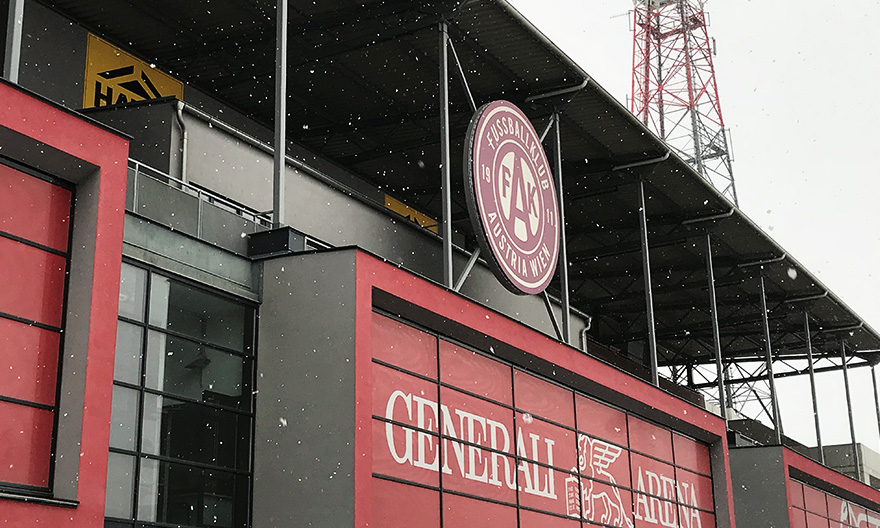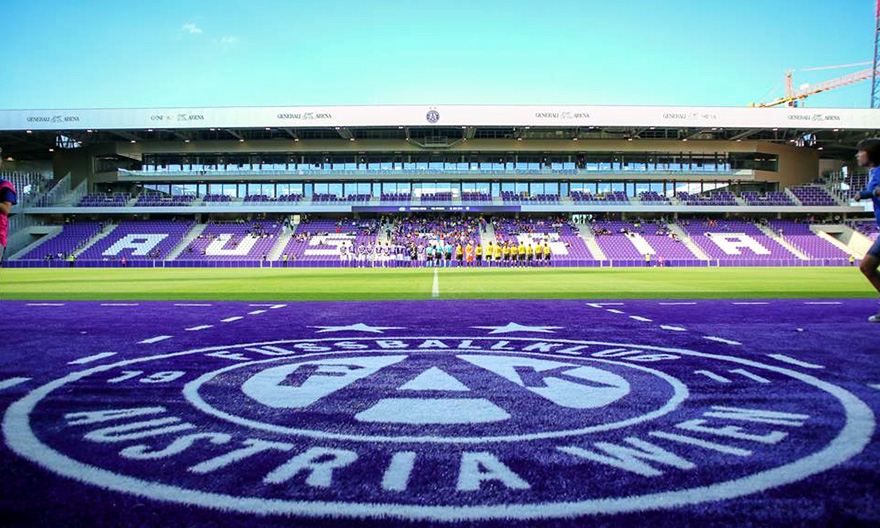The stadium’s recent renovation, carried out from 2016 to 2018, represents a major step forward, including in terms of sustainability.
The new Generali Arena
A win for Austria Wien
<p><strong>More than just a stadium</strong></p><p>Since the reopening last July, the stadium’s four grandstands now offer space for between 15,000 and 17,500 spectators. Besides the main stadium there are two training fields on the 96,000+ sqm grounds, along with a direct tube connection, a kindergarten, an academy area, offices, a museum and more.</p><p>The entire venue is now equipped with modern, higher-quality infrastructure, allowing it to be used for other events as well. The VIP club and underground car park have been enlarged (the latter comprising two areas of 6,000 sqm each), the lighting has been upgraded and the north and west grandstands were demolished and rebuilt.</p><p> </p><h5><strong>Three construction companies, one goal</strong></h5><p>A consortium of three construction companies was formed to execute this major project with joint responsibility. One paramount concern for the client FK Austria Wien was sustainability: the invitation to tender stated that the renovation had to be certifiable by the Austrian Society for Sustainable Real Estate Management (ÖGNI). Ecology, economics, technology and functional quality were thus equal priorities, meaning among other things that wherever possible, building materials were to be used which did not give off harmful emissions.</p><h5> </h5><p><strong>Lighting system and solar energy</strong></p><p>In today's age of HD and digital television, perfect lighting for the game action is a must. The new, more energy-efficient lighting system thus has a significantly higher lux number. Light sources were installed to prevent the grandstands from casting a shadow. At the same time, light pollution affecting the nearby gardens and residential areas was eliminated.</p><p>Post-renovation, the stadium now features the largest photovoltaic system employed by any Austrian football club. With total capacity of 340 kW, the system meets the stadium's energy needs – apart from the powerful floodlights, of course.</p><p> </p><h5><strong>Even the stadium is eco-friendly</strong></h5><p>Cooling elements are integrated into the ceilings in the VIP boxes that ensure pleasant temperatures without a draught. The modernised turf system activates the turf heating on the main playing field faster than before while using significantly less energy. The two training fields (one with artificial and one with natural turf) are likewise heated.</p><h5> </h5><h5><strong>Sophisticated roof drainage</strong></h5><p>Rain falling on the roofs is channelled into cisterns that hold up to 120 cubic metres of water, which can then be used to water the grass if needed. Excess water is then channelled on into seepage shafts, from which it seeps into the ground. This planning decision was made to relieve the burden on the sewer system and stabilise the groundwater level.</p><h5> </h5><h5><strong>Sustainable asphalt drainage</strong></h5><p>To drain the 10,000 sqm of asphalt on the stadium grounds – a large, sealed area – 600 metres of our FILCOTEN® tec and FILCOTEN® pro channels with Class C and D grates were used. These channels also conduct water into local seep pits, and are seamlessly integrated into the ecological planning concept just like all other construction measures.</p><p>The decision to deploy sustainable channels made by BG-Graspointner was made applying stringent criteria. The consortium developed a drainage concept in the project planning phase.</p><p> </p><p>Peter Wieninger, BG-Graspointner's Field Sales Rep for Vienna:</p>

Using hydraulic calculations we proved that our channels deliver the required hydraulic performance. And we were able to advise and support the client in various ways.
<p>Leopold Bogner, group site manager for construction firm Hazet Bau GmbH and manager of the renovation project:</p>

The BG-Graspointner solution won us over because it met all our requirements. From hydraulic calculations and cross-sections to safety, load-bearing capacity and sustainability."
<p>In this video, Mr Bogner talks about the dimensions of the project and the focus on environmental concerns.</p>
<p> </p><p>The tender invitation also specified that drainage channels must have anti-vandalism protection. Thus, in the relevant areas, screw-fastening cast-iron grates were used. A high load-bearing capacity was another requirement, and thanks to the mineral-rich, high-performance FILCOTEN® HPC (High Performance Concrete), it is no problem for mobile production units, fire engines or other heavy loads to drive over the channels.</p><h5> </h5><p><strong>Final score</strong></p><p>Many people say the stadium is a “gem”, reports Bogner – and you have to agree, with an eye-catching strip of artificial turf in the club's colour, purple, surrounding the playing field. Following the renovation, the stadium is now a state-of-the-art, future-proof venue, and visitor numbers are up. Even though the inaugural match last July went to BVB Dortmund 0:1, you could say it’s still a win for Austria Wien: A win for Austria Wien.</p><p>You can find out more about the material FILCOTEN® HPC <a href="/en-gb/produkte/bg-filcoten_pro/nw_100#eigenschaften">here</a>.</p>











